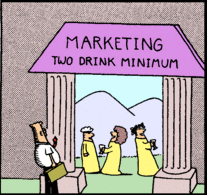Demystifiying Law Firm Marketing, Part 1: What is it?
/In my consulting practice I work with many sophisticated lawyers and experienced businesspeople. I also work with professionals, lawyers and businesspeople alike, who are exposed for the first time to new disciplines outside their comfort zone -- marketing, finance, pricing, project management, process improvement, and so on. Increasingly I've faced a number of questions on topics that some would argue have been long-settled. But one refreshing and challenging aspect of the dynamic legal marketplace is that there is a constant learning curve - and not everyone on that path is a fresh-faced graduate. So this series will address law firm marketing - what is it, how to do it, who should do it, how to hire and compensate marketing professionals, how to measure success, and much more. Readers with deep experience are welcome to offer insights or alternative views in the comments. Readers on the learning curve are invited to ask questions, in the comments or privately, to be addressed in future articles.
Recently I had lunch with a recruiter who specializes in placing senior marketing officers in prominent law firms. We had a wide-ranging discussion about the evolution of the law firm marketing function, the refreshing influx of new talent, the growth of pricing as a discipline, and much more.

When I asked him how this new climate had impacted the way he conducts searches, his disappointing reply was, “Not much at all.” He went on to add, “I often have a progressive discussion like this at the start of a new assignment, but too often what the partners demand, and what the law firm leaders settle on, are safe choices.” He explained that while some law firm leaders seek an innovative marketer to help drive the firm’s efforts, the partners by and large want someone who’s worked at several law firms, who will “keep the trains running on time,” and who won’t offend partners by creating distractions to their demanding billable hour focus. Oh how far we have… not… come!
Refreshingly, I work with more than a few law firms whose marketing function is by any measure progressive, innovative, comprehensive, and grounded in financials and analytics. But there are far fewer of these examplars than the size of the legal market would otherwise suggest. Why is this? Why do so many law firms, and law firm partners, continue to struggle with understanding the role and impact of professional marketing? Why, when faced with declining financial fortunes, or at least the clear and unambiguous risk of increased competition and price pressure, do law firm leaders double down on what they’ve always done rather than seek new ways of doing business? The answer is nuanced, but at its core I suggest it boils down to this: lawyers don’t understand what marketing is, and they don’t understand the skills necessary to do it well.
When I advise law firms on improving the Marketing function, I find it helpful to start first by defining terms. We can quibble over the textbook definitions, but the practical reality is that there is a difference between marketing and business development, and each of these is distinct from activities in which some law firms engage that might best be characterized as “community involvement.” Let’s break these down.
Marketing
Marketing is about creating visibility and awareness of the firm’s and the lawyers’ credentials and capabilities, with the ultimate objective to be included in the “consideration set” when a prospective client needs outside counsel to address a business issue. And while law firms have produced a lot of marketing activity over time, some of it – and depending on your perspective, perhaps much of it – hasn’t been all that helpful in generating leads or winning work, even if it has won awards for creativity. This isn’t necessarily the fault of the chosen marketing tactics. It may very well be that the firm directed its marketing message to the wrong audience, or invested in tactics that didn’t expose the firm to potential buyers. This tends happens when the profession believes that “all revenue is good revenue” and “first let’s win the work and then we’ll figure out how to do the work.” How do you know who to target, and what to say, and how to say it, and who you’re competing with?
Business Development
Business Development is about advancing an opportunity from “who should we talk to?” to “we may be able to help” to “and here’s how we’ll do it” to winning the work and generating fees from a new matter. And unlike traditional marketing, much of which can be delegated to competent professionals to address, business development relies heavily on direct lawyer involvement and not solely on the shoulders of experienced BD professionals. After all, Business Development is essentially sales. This means identifying which clients or industries to pursue, being clear about what problems we solve, understanding a potential client’s needs, establishing alternatives for addressing the needs, quantifying the impact of proposed solutions, and quantifying the costs and risks of doing nothing. Some of this is handled by lawyers; some of this can be addressed by BD professionals. But none of it happens without a plan. Or at least it’s not typically very effective without a plan. Yet few law firms, and even fewer individual partners, have a well-designed and thoughtful plan for growing their practice.
Instead, some law firms invest time and energy into programs that are, at best, tangentially helpful to exposing the brand to potential buyers. These “random acts of marketing” sometimes work, and sometimes the prospective client hires a lawyer in spite of ineffective marketing tactics. And this reinforces poor behavior. To be clear, it’s not the tactic itself that may be wanting. It’s not knowing whether the tactic is effective or not. What works for one may not work for another; there is no universal “best practices” and certainly little to be gained by parroting what other firms in dissimilar markets with dissimilar practices and with dissimilar clients do to market their services. For some firms, purchasing a luxury suite at a sports arena is a well-designed tactic used effectively to foster new relationships or cement existing ones. For others, it’s an expensive investment in the wrong audience. Some lawyers will sit on charity boards and access a network of like-minded professionals; others donate time to an endeavor that has a one in a million chance of exposing the firm to qualified potential buyers. Some partners participate in practice-specific bar meetings, interacting with rivals who are unlikely to refer business. Yet other partners may derive great benefits from referrals from other members of the Bar, even from rivals facing a conflict. If you aren’t measuring the impact of your marketing and business development, how do you know if it’s working?
Many firms confuse volume with effectiveness. So filling a large hotel ballroom for a seminar on some new regulatory changes has better optics than a hosting a handful of clients in a small, corner conference room in the firm, even when the small room consists of senior decision makers and the large room is filled with juniors. Or a newsletter pushed to 10,000 names on our mailing list with only a 5% bounce rate is considered more successful than a blog post with only a few hundred views, irrespective of which approach provokes an inquiry to the lawyer who authored the piece. Securing a lucrative and expensive sponsorship at a notable client industry black tie dinner is deemed a coup, until none of the partners confirmed to attend actually show up and the firm’s table sits empty and forlorn.
Community Involvement
Many firms confuse community involvement with marketing. There’s nothing wrong with sponsoring a local charity’s 5k race, but the partner who participates in the run, whose clients are primarily sovereign wealth fund bankers based overseas, shouldn’t consider this as an effective business development tactic for his practice. Law firms should invest in their communities, and there’s a certain amount of brand building that is expected. But at a certain point, we have to shift from general awareness to specific targeting, specific messages, specific solutions, and specific tactics. And we must measure, analyze, and adjust to stay on top of new developments.
The overriding challenge is to first understand the fundamental differences between marketing, business development, and community involvement. After that we’re in a better position to hire the right professionals with the right experience who can advise, plan, and help execute the firm’s marketing and business development plan. The partners must hold themselves accountable to pursuing the plan and not sitting back and hoping others grow the firm. And we must all measure the effectiveness of our actions, and adjust our approach as needed.
Timothy B. Corcoran is the 2014 President of the Legal Marketing Association and an elected Fellow of the College of Law Practice Management. He delivers keynote presentations, conducts workshops, and advises leaders of law firms, in-house legal departments, and legal service providers on how to profit in a time of great change. To inquire about his services, contact him at +1.609.557.7311 or at tim@corcoranconsultinggroup.com.



